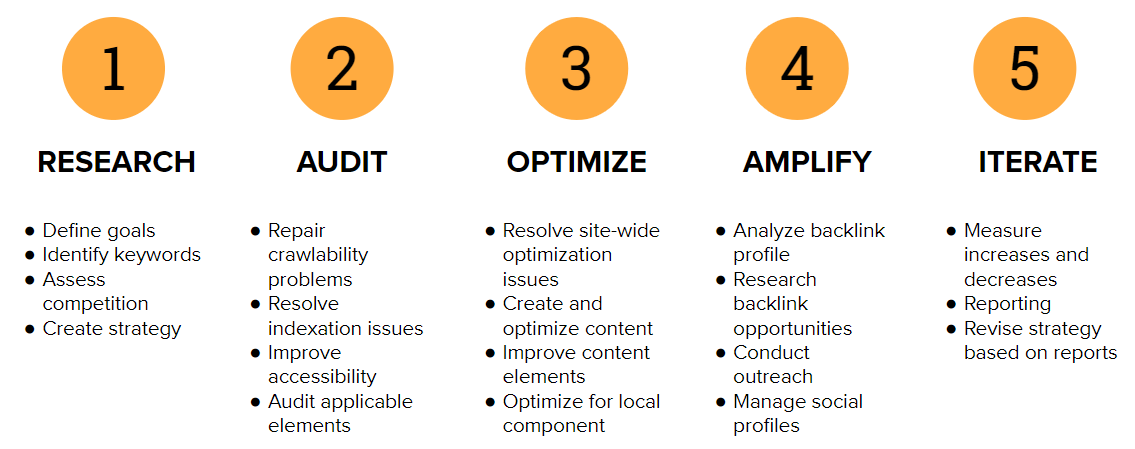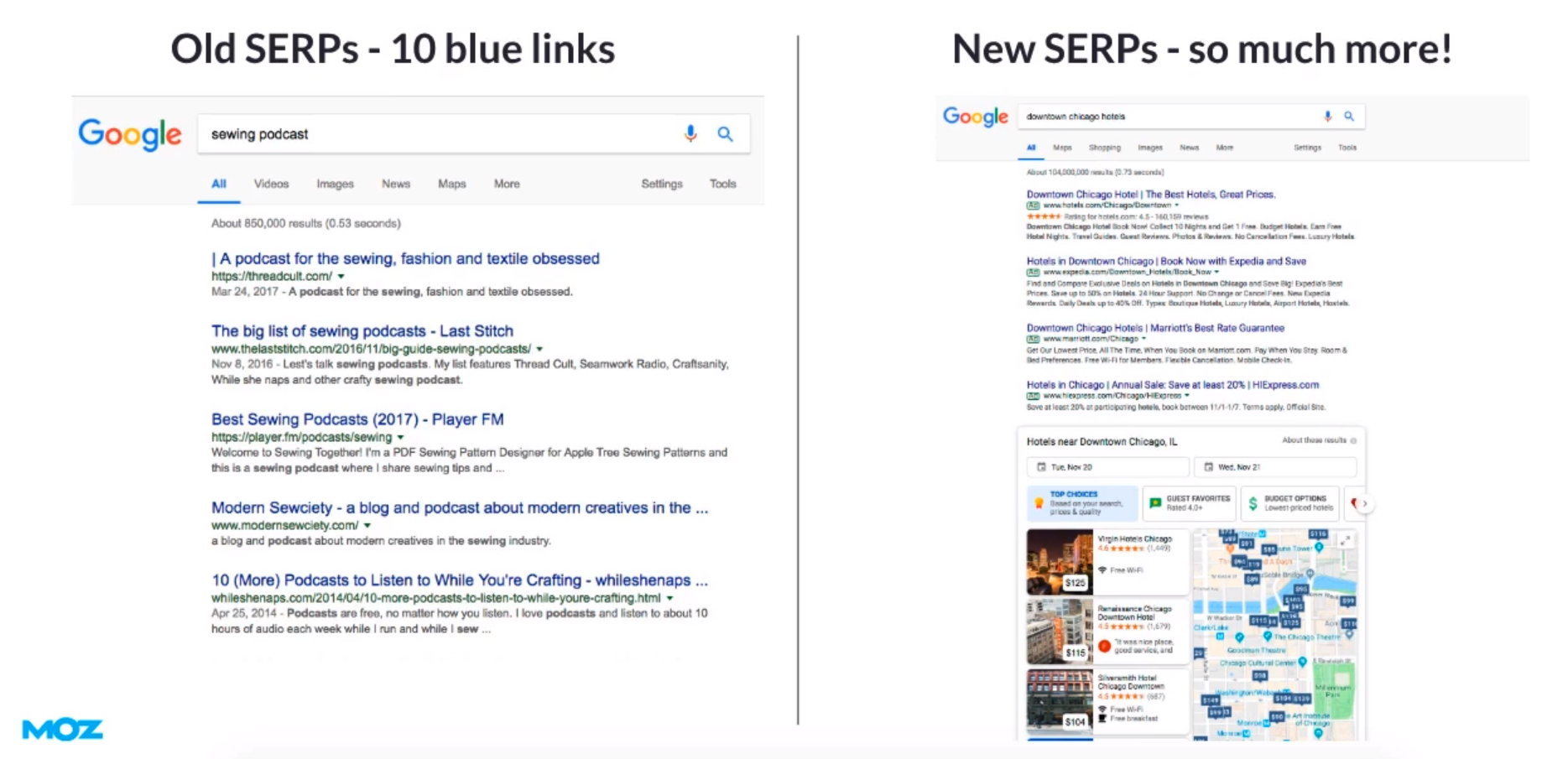What you’re probably missing from your SEO strategy
By: Carly McCrory
December 11, 2019 | Reading Time: 5 mins
Search Engine Optimization. What a buzz word. Most people have heard of it, some marketers may have dabbled in it, but there are very few people with a true understanding of what a real SEO strategy entails.
“But Carly, SEO is basic stuff,” you may say. “I know about optimizing for Google, writing meta descriptions, keywords, yadda yadda. I can just plug in Yoast and call it a day, right?”
Wrong. So very wrong, my friend.
There’s more to SEO than you probably realize because it’s constantly changing. I didn’t want to fall behind, so I enrolled in the Moz SEO Essentials Certificate course. If you’re looking to upgrade your marketing knowledge and save yourself from becoming an SEO dinosaur, I highly recommend it. But if you want to save some time and money, stick with me as I run through the world of SEO. [/intro]

What exactly is SEO?
We’ll start with the basics. Moz defines search engine optimization as “the practice of increasing the quantity and quality of traffic to your website through organic search engine results.”
Okay, so what does that actually mean? Let’s break it down a bit further. Getting tons of website traffic is great, but what you really want is quality traffic — relevant leads that are actually interested in what you offer. There are many ways of getting users to your websites, like display ads and direct linking, but SEO is focused on organic traffic coming through Google, DuckDuckGo, Bing, and other search engines (seriously, some people actually use Bing).
How it works
Though you may think of Google as the mysterious genie that can answer all of your questions, there’s a lot that goes into assembling that magical list of search results. Google is constantly sending out Googlebot spiders to find what pages exist on the web. These little bots crawl known websites and find new ones through links. Next, they index what they found. They attempt to understand the content by looking at page titles, keywords, and formatting structure. Using all of this information, Google serves and ranks specific pages based on a user’s search query.
It is estimated that Google uses over 200 ranking factors to determine where your page lands in search results. Ultimately, proper SEO will help you adhere to those factors.
Setting up an SEO strategy the right way
Good SEO starts with a good strategy. Moz suggests you stick to their tried-and-true methodology, which includes 5 stages: Research, Audit, Optimize, Amplify and Iterate. Where lots of marketers go wrong is they skip right to Optimize because it contains the more high-profile tasks like titles, URL slugs, descriptions, and other metadata. While those things are important and have a lot of value, they’re just a small piece of the puzzle!

If there’s one key takeaway from this blog, let it be this: Do not skip the Research and Audit stages. Conducting proper keyword research will set a solid foundation for the rest of your strategy. Not only is it a great exercise to see where your brand fits in a competitive industry, but it’ll also help set the stage for building new web content and give a comprehensive view of your strengths and weaknesses at different stages of the funnel.
Keyword research for dummies
One of the easiest ways to build out a good keyword list is by setting up a matrix, Mr. Anderson. You can start by creating a grid that is sorted by Sales Funnel and Semantic Topics. Some examples of topics might be your buyer’s needs, buyer personas, or product/service line.
Why are the sales funnel stages relevant, you ask? It’s estimated that around 80% of searches are informational. This means the searcher is usually at the top or middle stage of the sales funnel, and they may not even know what their problem is yet. Since these searches are further away from conversion, there are generally fewer ads to compete with for keywords. It’s easier (and cheaper) to capture the audience at the top and guide them through the funnel rather than capturing them at the bottom.

Once you’ve built out your matrix you can create a keyword list from each cell. Moz suggests 400-500 keyword variants per cell. That may seem like a lot, but there are tons of handy tools out there to make your life easier, like the Moz Keyword Explorer. When you’re finished building your list, it’s time to filter and sort to identify target keywords. You want to look for keywords with high search volume, a high organic click-through rate, and a low difficulty ranking.
Finished? Then you’re well on your way to becoming a master SEO strategist. With this matrix at your fingertips, you can move through the next stages of the SEO Methodology by mapping your new keywords to the right pages. You’ll keep coming back to this matrix throughout the optimization process, so keep it handy.
Google is constantly changing its algorithms
Even if you follow this SEO methodology to a T, your SEO strategy will never truly be finished. In the field of marketing, everything is constantly changing and SEO is no different.
Over the years, Google has made significant changes to how, what, and why its search engine algorithm shows results. Does anybody else remember the good old days, when searching for something on Google resulted in a long list of plain ‘ol, blue links? Search the same query today, and you’ll likely be bombarded by Google Ads, image results, similar questions, map packs and more. You’ll probably have to scroll quite a ways before you find an actual organic link.

I’ll let you in on a little secret: Google doesn’t want you to leave Google. Okay, maybe everyone knew that already. If you stay in the search results, you’re more likely to click on an ad and make them some money. Google is making updates to its algorithm now on a monthly, if not weekly basis. While most of these changes are insignificant and go unnoticed, you have to stay ready for when something major happens.
These revolutionary updates — like mobile-first indexing — can completely change how links are shown and ranked organically. When mobile-first indexing dropped in 2018, businesses with slow, non-mobile sites waved goodbye to organic traffic. The strategy you use today could be useless tomorrow. The only constant is change.
What’s next?
Thankfully, Google usually announces what and when they’ll be doing. They’re also kind enough to provide tips and tricks on how to prepare for the coming changes. We recommend following the Google SearchLiason Twitter account to help stay on top of any changes. For more insights and strategies, check out Moz, Yoast and Search Engine Land. There’s no shortage of resources online to help you through SEO. The first step in becoming a master is admitting and understanding that you’re not a master. There’s a lot to learn and there’s no time like the present to get started.








